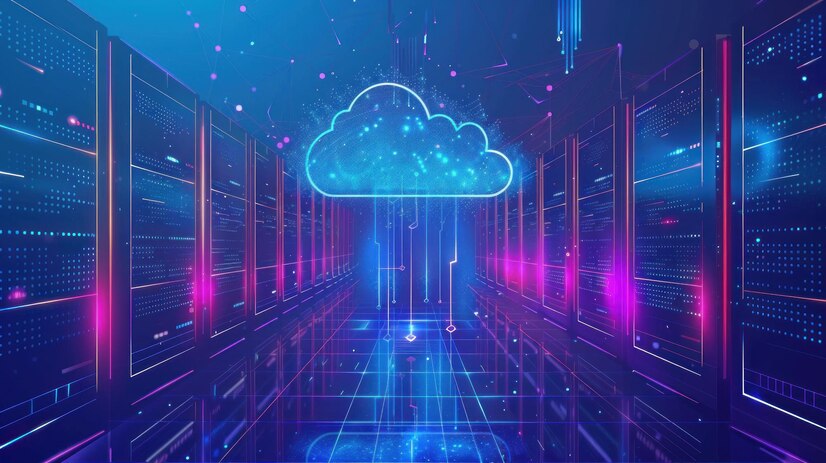Have you ever heard about a “cloud” in terms of data maintenance and internet space? Well, the “cloud” refers to a network of remote servers that store, manage, and process data over the Internet rather than locally on a personal computer or server. These servers are hosted in data centers around the world, enabling users to access data, applications, and services from anywhere with an Internet connection.
Cloud computing can also refer to a type of data center that allows for scalable, on-demand access to computing resources, eliminating the need for physical storage and hardware management on individual devices. What is a cloud data center, and what sets it apart from other types of data center? This is exactly the question we are going to answer in this article of dana cloud.
If you want to know about data center tiers come here.
Understanding Cloud Data Centers
A cloud data center is a physical facility built to support cloud computing, housing servers and hardware that store, manage, and process data for cloud services. Unlike traditional data centers dedicated to a single organization, cloud data centers are designed for multi-tenancy, meaning they securely host resources for multiple clients on a shared infrastructure. That’s why many companies choose it over other types: it’s highly versatile.
While the cloud is a virtual environment (or service layer) that users interact with over the internet, cloud data centers are the backbone behind these virtual services. Cloud providers like AWS, Google Cloud, and Microsoft Azure operate numerous cloud data centers worldwide to ensure that users can access resources on demand with high reliability, low latency, and strong data integrity.
Read more: What is a Colocation Data Center?
Benefits of a Cloud Data Center
The greatest benefit that a cloud center provides you is accessibility. Anywhere you are (in the whole world), all you need to access your data in the cloud center is a stable internet connection. Here are some of the other benefits of a cloud data center:
- Scalability: Quickly scale resources up or down based on demand without needing physical hardware adjustments.
- Cost Efficiency: Reduces the need for large upfront investments in physical infrastructure; users only pay for the resources they use.
- High Availability: Cloud data centers use redundant systems and geographically distributed locations to ensure minimal downtime and robust disaster recovery.
- Enhanced Security: Leading providers invest in advanced security protocols, data – encryption, and constant monitoring to protect against cyber threats.
- Automated Updates: Regular updates and maintenance by providers reduce the need for manual updates, keeping systems optimized.
- Resource Optimization: Efficient allocation of resources improves performance and reduces waste, making operations more sustainable.
- Rapid Deployment: New applications and services can be deployed quickly, accelerating innovation and response times.
Related article: What Is a Micro Data Center?
Colocation Data Center Vs Cloud Data Center
colocation data centers and cloud data centers differ primarily in control, infrastructure ownership, and flexibility. In a colocation data center, businesses lease space to house their own physical servers and network equipment. They maintain control over hardware, software, and data, with the colocation provider managing infrastructure essentials like power, cooling, and security. This option suits businesses that need specific hardware configurations, regulatory compliance, or direct management over IT infrastructure.
In contrast, a cloud data center provides virtualized resources over the internet. Here, the cloud provider owns and maintains all hardware, offering clients flexible, on-demand access to computing resources without the need for physical equipment. This highly scalable model allows businesses to adjust resources as needed, paying only for what they use. However, users have limited control over hardware and must rely on the provider’s security protocols.
Read more: What is Hyperscale data center?
Types of Cloud Data Center
One of the most important things in selecting a data center is for the company to know its needs and decide based on the level of service that fits it. Based on accessibility, function, and size, cloud data centers are often categorized into the following:
-
Public Cloud Data Centers
Public cloud data centers are managed by third-party providers, such as AWS, Google Cloud, and Microsoft Azure, who rent out resources to multiple clients.
-
Private Cloud Data Centers
Private cloud data centers are dedicated to a single organization, providing greater control over data and enhanced security. They can be hosted on-site or by a third-party provider.
-
Hybrid Cloud Data Centers
Hybrid cloud data centers combine public and private cloud elements, enabling data and applications to move between them as needed. This setup allows organizations to keep sensitive data within a private environment while benefiting from the scalability and cost savings of a public cloud for less critical operations.
-
Multi-Cloud Data Centers
In a multi-cloud setup, an organization uses multiple public cloud providers, allowing them to optimize services based on specific needs and avoid dependency on a single provider.
Read more: What is an Edge Data Center?
-
Edge Cloud Data Centers
Edge cloud data centers bring computing resources closer to end users by distributing smaller data centers geographically. This setup is ideal for applications requiring low latency, like IoT or real-time analytics, as it reduces the time it takes for data to travel between the user and the cloud.
Difference Between a Data Center and a Cloud
A cloud data center is, at its core, a type of data center. But what is a data center?
It’s a physical facility that houses servers, storage devices, and networking equipment dedicated to managing and storing data for a specific organization. It typically requires significant capital investment in hardware, maintenance, and physical security. However, a cloud provides a virtualized environment where data and applications are hosted on remote servers operated by third-party providers. This model allows for on-demand access to computing resources over the Internet, significantly reducing the need for physical hardware and associated management.
Here are the key differences between cloud centers and data centers:
- Ownership: Data centers are owned and operated by the organization, while cloud services are managed by external providers like AWS, Google Cloud, or Microsoft Azure.
- Cost Structure: Data centers require upfront capital investment, whereas cloud services operate on a pay-as-you-go model, allowing organizations to pay only for what they use.
- Scalability: Cloud services offer rapid scalability without the need for physical hardware changes, while scaling a traditional data center often requires time-consuming upgrades and installations.
- Accessibility: Cloud services enable access from anywhere with internet connectivity, while data centers may be limited to on-site access or require secure remote connections.
Read more: Data Center Electromagnetic Waves
How Cloud Data Centers work?
Now, we know that the main task of a cloud data center is to facilitate managing and providing housing for data. But how does it do that task? Here is all you need to know:
- Infrastructure Setup: Cloud data centers are equipped with numerous servers, storage devices, and networking hardware, all housed in a secure facility.
- Virtualization: The physical hardware is virtualized using software, allowing multiple virtual machines (VMs) to run on a single physical server. This optimizes resource usage and enhances flexibility.
- Resource Allocation: When a user requests resources, the cloud management software allocates the necessary VMs and storage based on the application or service’s specific requirements.
- Load Balancing: Traffic is distributed evenly across servers using load balancers to prevent any single server from becoming overwhelmed, ensuring optimal performance.
- Data Storage: Data is stored across various disks and devices, with redundancy measures, such as replication and backups, in place to prevent data loss.
- Security Measures: Continuous monitoring, firewalls, and encryption protocols protect data from unauthorized access and cyber threats.
- Scalability: Resources can be easily scaled up or down in response to demand, enabling businesses to adjust their usage without downtime.
- User Access: Users interact with cloud services via the internet, accessing applications and data from anywhere, ensuring seamless connectivity and usability.
Read more: What is an enterprise data center?
FAQs
-
How does a cloud data center handle peak demand?
It uses load balancing and scaling to allocate resources instantly, ensuring steady performance.
-
What environmental benefits do cloud data centers offer?
They use energy-efficient tech and renewable energy, reducing the need for smaller, less efficient data centers.
-
Can cloud data centers support compliance with regulations?
Yes, they’re designed to meet standards like GDPR and HIPAA, with tools to help manage data location and access.


